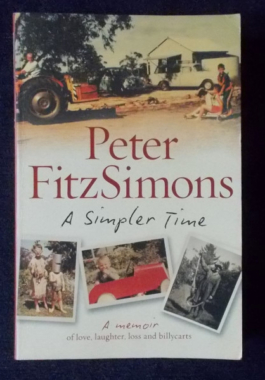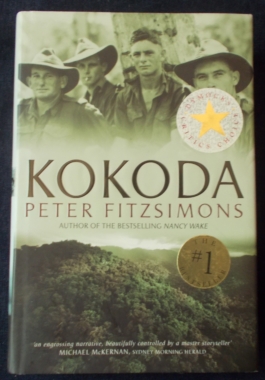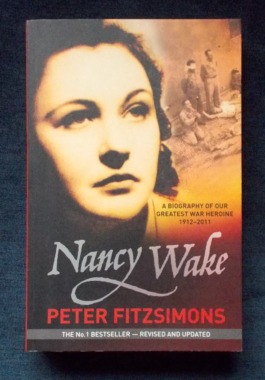Peter Fitzsimon's account of growing up on the rural outskirts of Sydney in the 1960s is first and foremost a tribute to family. It's also a salute to times and generations past, when praise was understated and love unstinting; work was hard and values were clear; when people stood by each other in adversity. Days were for doing. Here is a childhood full of mischief, camaraderie, eccentric characters, drama, love, loss and billy-carts.
-

-
 In 1854, Victorian miners fought a deadly battle under the flag of the Southern Cross at the Eureka Stockade. Though brief and doomed to fail, the battle is legend in both Australian history and in the Australian mind. Henry Lawson wrote poems about it; its symbolic flag is still raised; and even the nineteenth - century visitor Mark Twain called it: ''a strike for liberty''. Was this rebellion a fledgling nation's first attempt to assert its independence under colonial rule? Or was it merely rabble-rousing by unruly miners determined not to pay their taxes?
In 1854, Victorian miners fought a deadly battle under the flag of the Southern Cross at the Eureka Stockade. Though brief and doomed to fail, the battle is legend in both Australian history and in the Australian mind. Henry Lawson wrote poems about it; its symbolic flag is still raised; and even the nineteenth - century visitor Mark Twain called it: ''a strike for liberty''. Was this rebellion a fledgling nation's first attempt to assert its independence under colonial rule? Or was it merely rabble-rousing by unruly miners determined not to pay their taxes? -
 Sport was never meant to be complicated. No gibberish, no statistics, no talk of green-zones, black-zones, channels and percentage plays, no cheating, no grubbiness and certainly no ball-tampering. Peter Fitzsimons celebrates the good, the generous and the kind in Australian sport: the genuine characters, the national treasures and the special moments when the losers were the true champions and the game - whichever game - was done proud. There really are good men and women in sport, fair play still exists and anyone can be a winner.
Sport was never meant to be complicated. No gibberish, no statistics, no talk of green-zones, black-zones, channels and percentage plays, no cheating, no grubbiness and certainly no ball-tampering. Peter Fitzsimons celebrates the good, the generous and the kind in Australian sport: the genuine characters, the national treasures and the special moments when the losers were the true champions and the game - whichever game - was done proud. There really are good men and women in sport, fair play still exists and anyone can be a winner. -
 A celebration of chest-puffing, heart-lifting goodness and kindness from around Australia. You gotta love this country when an AFL legend takes his mum instead of his girlfriend to the Brownlow; when an Australian cricket captain joins a bunch of fourteen year olds for a bit of street cricket; when a bloke wins the Australian Marbles Championship after being reunited with the tom-bowlers his brother threw away forty years ago; and when the dry cleaner down the road is called Drop Your Pants. Here's the good, the generous, the kind and the downright strange in this hilarious collection of stories from daily life and grassroots sporting fields around the country.
A celebration of chest-puffing, heart-lifting goodness and kindness from around Australia. You gotta love this country when an AFL legend takes his mum instead of his girlfriend to the Brownlow; when an Australian cricket captain joins a bunch of fourteen year olds for a bit of street cricket; when a bloke wins the Australian Marbles Championship after being reunited with the tom-bowlers his brother threw away forty years ago; and when the dry cleaner down the road is called Drop Your Pants. Here's the good, the generous, the kind and the downright strange in this hilarious collection of stories from daily life and grassroots sporting fields around the country. -
 The name Captain James Cook is one of the most recognisable in Australian history - an almost mythic figure who is often discussed, celebrated, reviled and debated. But who was the real James Cook? This Yorkshire farm boy would go on to become the foremost mariner, scientist, navigator and cartographer of his era, and to personally map a third of the globe. His great voyages of discovery were incredible feats of seamanship and navigation. Leading a crew of men into uncharted territories, Cook would face the best and worst of humanity as he took himself and his crew to the edge of the known world - and beyond. Focusing on his most iconic expedition, the voyage of the Endeavour, where Cook first set foot on Australian and New Zealand soil, there is another figure who looms large in Australasian history: Joseph Banks, the aristocratic botanist. As they left England, Banks, a rich, famous playboy, was everything that Cook was not. The voyage tested Cook's character and would help define his legacy. This is the man behind the myth. Illustrated with black and white and colour photographs.
The name Captain James Cook is one of the most recognisable in Australian history - an almost mythic figure who is often discussed, celebrated, reviled and debated. But who was the real James Cook? This Yorkshire farm boy would go on to become the foremost mariner, scientist, navigator and cartographer of his era, and to personally map a third of the globe. His great voyages of discovery were incredible feats of seamanship and navigation. Leading a crew of men into uncharted territories, Cook would face the best and worst of humanity as he took himself and his crew to the edge of the known world - and beyond. Focusing on his most iconic expedition, the voyage of the Endeavour, where Cook first set foot on Australian and New Zealand soil, there is another figure who looms large in Australasian history: Joseph Banks, the aristocratic botanist. As they left England, Banks, a rich, famous playboy, was everything that Cook was not. The voyage tested Cook's character and would help define his legacy. This is the man behind the myth. Illustrated with black and white and colour photographs. -

Kokoda: Peter Fitzsimons
$12.00The Kokoda Track is the symbol of World War II for Australians. This book takes readers up that tortuous track and into battle with the young men who fought there, following in the footsteps of heroes and villains as they climb the endless mountain ranges, dig into defend, charge into battle or begin the long, desperate and bloody trek to safety. Here can also be found the perspective of the Japanese troops and the extraordinary local people who the Diggers called 'angels'.
-

Kokoda: Peter Fitzsimons
$20.00The Kokoda Track is the symbol of World War II for Australians. This book takes readers up that tortuous track and into battle with the young men who fought there, following in the footsteps of heroes and villains as they climb the endless mountain ranges, dig into defend, charge into battle or begin the long, desperate and bloody trek to safety. Here can also be found the perspective of the Japanese troops and the extraordinary local people who the Diggers called 'angels'. -

Nancy Wake: Peter Fitzsimons
$15.00In the early 1930s, Nancy Wake was a young woman enjoying a bohemian life in Paris. By the end of the Second World War, she was the Gestapo's most wanted person. As a naïve, young journalist, Nancy witnessed a horrific scene of Nazi violence in a Viennese street. From that moment, she declared that she would do everything in her power to rid Europe of the Nazis. What began as a courier job here and there became a highly successful escape network for Allied soldiers, perfectly camouflaged by Nancy's high-society life in Marseille. Her network was soon so successful - and so notorious - that she was forced to flee France to escape the Gestapo, who had dubbed her "the white mouse" for her knack of slipping through its traps. But Nancy was a passionate enemy of the Nazis and refused to stay away. Supplying weapons and training members of a powerful underground fighting force, organising Allied parachute drops, cycling four hundred kilometres across a mountain range to find a new transmitting radio - nothing seemed too difficult in her fight against the Nazis.Illustrated with black and white photographs. -

Nene: Peter Fitzsimons
$9.00Nene King was the queen of the Australian magazine world. For over four years King increased the circulation of Woman's Day by 400,000 sales a week. No cheque was too large to write, no paparazzi shot too intrusive, no story too outrageous - so long as she could serve up the must-have stories for her readers. In the late 80s and into the 90s, if there was a scandal happening somewhere in the world, chances are that Woman's Day would have an exclusive - with photos. She took the magazine to the number one spot and she became on of Australia's most powerful women - feared by the stars, courted by politicians, Kerry Packer's confidante and Queen Bee of the celebritocracy. She was in the Beatles' motel room when they visited Australia; she arrived in London in time for the Summer of Love and lived in South East Asia during the turbulent years of the Vietnam War. She went all the way from interviewing a young housewife by the name of Hazel Hawke - to interviewing the same Hazel and paying her a king's ransom for her side of the break-up with Bob and along the way interviewed Mae West and met Princess Diana. Keeping hr going for 22 years was the great love of her live, Patrick Bowring. But on May 24, 1996, Nene's life changed forever.

